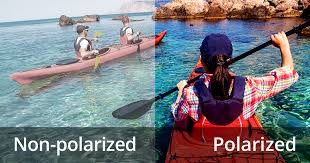Polarized sunglasses have been popular for years with boaters and fishermen who need to reduce reflected glare from the water surrounding them.
But now that many others who spend time outdoors have discovered the benefits of polarized lenses, interest in these types of sunglasses has soared.
Besides boaters, outdoor enthusiasts who benefit the most from polarized sunglasses include skiers, bikers, golfers and joggers, all who may enjoy a clearer view along with elimination of glare.
These sunglasses can be used for driving and, in fact, can reduce glare from a long, flat surface such as the hood of the car or the road’s surface.
Polarized sunglasses also can be worn indoors by light-sensitive people, including post-cataract surgery patients and those continually exposed to bright light through windows.
How Do Polarized Lenses Work?
Light reflected from surfaces such as a flat road or smooth water generally is horizontally polarized. This means that, instead of light being scattered in all directions in more usual ways, reflected light generally travels in a more horizontally oriented direction. This creates an annoying and sometimes dangerous intensity of light that we experience as glare.

Polarized sunglasses cut glare and haze so your eyes are more comfortable and you can see better.
Polarized lenses contain a special filter that blocks this type of intense reflected light, reducing glare.
Though polarized sunglasses improve comfort and visibility, you will encounter some instances when these lenses may not be advisable. One example is downhill skiing, where you don’t want to block light reflecting off icy patches because this alerts skiers to hazards they are approaching.
In addition, polarized lenses may reduce the visibility of images produced by liquid crystal displays (LCDs) found on the dashboards of some cars or in other places such as the digital screens on automatic teller (bank) machines.
With polarized lenses, you also may be unable to see your cell phone or GPS device. Boaters and pilots also have reported similar problems when viewing LCD displays on instrument panels, which can be a crucial issue when it comes to making split-second decisions based strictly on information displayed on a panel.
However, for most other sports and activities, polarized sunglasses offer great advantages. And today, many polarized lenses are available in combination with other features that can enhance outdoor experiences. These Cocoons OveRx sunglasses with a blue mirror finish are worn over prescription eyewear. They have polarized lenses that work well for deep sea anglers, who need a lot of protection from glare.
Polarized bifocal sunglasses or progressive lenses are examples of options for the presbyope who also likes outdoor sports.
And polarized photochromic lenses, which change from dark outside to light inside, may be right for the light-sensitive person who frequently is in and out of the sun on any given day.
Whether you spend your time waterskiing or boating, in-line skating or mountain biking, driving or jogging, polarized sunglasses may be the right choice to help you enjoy your life outdoors.
To have more information, please feel free to consult with our best optometrists in KL.


